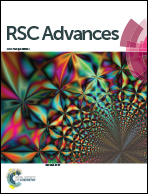Catalytic hydrogenation of 2-ethylanthraquinone using an in situ synthesized Pd catalyst
Abstract
An in situ synthesized Pd catalyst with an egg–shell structure was employed to catalyze the hydrogenation of 2-ethylanthraquinone in a fixed bed. The effects of residence time, gas to liquid phase ratio, reaction temperature and Pd loading amounts on the yield and hydrogenation efficiency were investigated specifically. The yield and hydrogenation efficiency attained values of 35.5% and 6.6 g L−1 using the optimum Pd loading amount of 0.32%, respectively, with a residence time of less than 4 seconds and exhibiting excellent catalytic activity. Meanwhile, within the temperature range of 50 °C to 70 °C, the Thiele modulus and effective internal diffusion factors were calculated to be about 0.008 to 0.033 and 0.9996 to 0.9999, respectively, which indicates that the prepared catalyst with an egg–shell structure weakened the internal diffusion resistance effectively and is suitable for fast reactions. The maximum space time yield value reached 567.5 gH2O2 gPd−1 h−1 and was much higher than the reported results from other literature.


 Please wait while we load your content...
Please wait while we load your content...